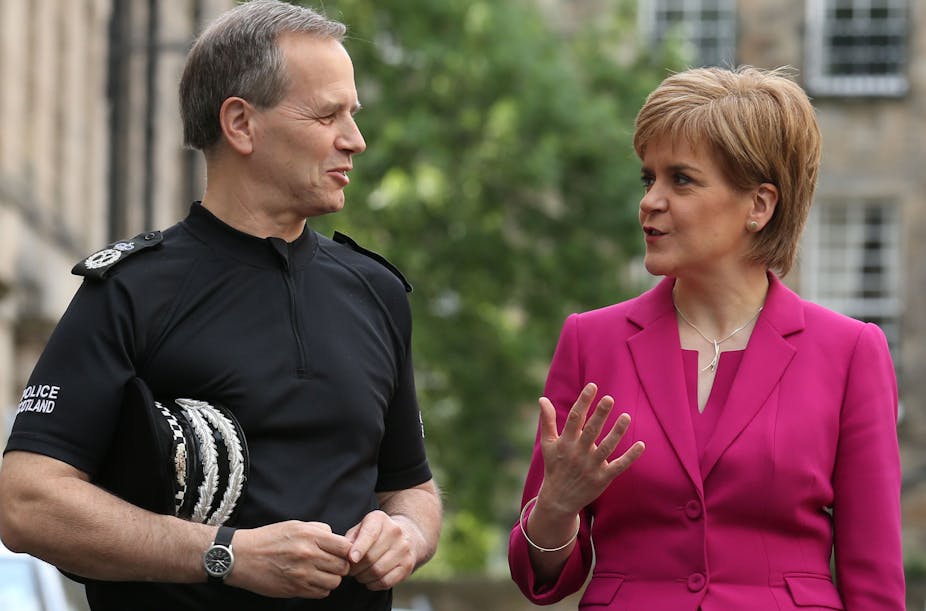Nicola Sturgeon recently admitted that the lowest point of her 18 months as Scottish first minister was when John Yuill and Lamara Bell died on the M9 in 2015 following a police call that was not acted upon.
It went to the heart of the problems caused by the 2013 decision to create Police Scotland via a merger of eight regional forces, and was the final straw for the tenure of inaugural chief constable Stephen House. It capped a difficult five years in justice for the Scottish government, the effects of which will continue to play out for some time to come.
In the SNP manifesto of 2011, the plan to create Police Scotland was not made clear to voters. The headline demand on policing focused on extra officers on the beat. There was no mention of one national force with all its associated problems of accountability. If you dig quite deep, you find only this ambiguous statement: “In order to maintain the increased visible police presence we will reduce the number of police forces in Scotland.”
The first years of Police Scotland, which is seen as a potential model for England and Wales, were defined by the powerful House and some controversial police tactics. Stop and search was introduced across the whole of the country at unprecedented levels, particularly against young people. Over half a million searches were carried out in the first year of Police Scotland, the equivalent of one in ten of the country’s population being subjected to one.
At the height of its use, people in Scotland were four times more likely than anywhere else in the UK to be searched. Most searches were deemed to be “consensual” – agreed to by the participants, including children who are legally too young to consent. When the facts emerged, the government called an inquiry under John Scott QC, who last year recommended a complete end to consensual search.
House, previously of the London Metropolitan Police and then the former Strathclyde force, also tried to use armed police in parts of the country on routine patrols. The outcry was again met by an official investigation – this time by the Inspectorate of Constabulary. The policy was hastily withdrawn in 2014.
House out, Gormley in
These controversies raised suspicions that Police Scotland was taking advantage of the transition to a single service. The force’s relationships with Holyrood, communities and the new watchdog, the Scottish Police Authority, were all unclear. This made it easier for the new force to dodge the questions of who it had to answer to.

The chief constable resigned soon after the Yuill/Bell incident last August with a year left on his contract. He was replaced by Phil Gormley, who like him was a trained London Met officer, but the Scottish government could not evade responsibility for what happened on House’s watch. While the police force is supposed to be completely independent from political oversight, justice ministers Kenny MacAskill and then Michael Matheson had no choice but to get involved in every row.
They also commissioned an investigation by the Scottish Police Authority into Police Scotland’s local accountability, which offered few concrete ideas that would help. Over the past five years, the government’s central message has been that a national police force would enhance local accountability. This has always sounded contradictory.
Policing has arguably taken up more official reports in Scotland in the last five years than any other issue except the independence referendum. And as an issue, it is also unlikely to go away. One foreseeable source of aggravation is that Phil Gormley previously had direct supervisory responsibilities for the undercover Special Demonstration Squad in London. The SDS is currently the subject of a public inquiry over how it used undercover policing to infiltrate radical groups.
The review is currently only looking at England and Wales, but there are increasing demands from across the political spectrum to extend it to Scotland, following revelations about police activity including the monitoring of activists north of the border. Gormley has said that despite his overall responsibilities, he didn’t know of SDS’s existence.
Justice trouble
Tied to the government’s woes over Police Scotland is the Offensive Behaviour at Football and Threatening Communications (Scotland) Act 2012, which gave the police tough powers over sectarian abuse during matches. It has been argued to be unnecessary and even an invasive attack on the human rights of supporters. Celtic, Scotland’s leading football club, wants parts of the legislation repealed, while all the political parties apart from the SNP want it abolished.

Kenny MacAskill, the architect of Police Scotland, also sought to abolish the traditional Scots Law procedure of corroboration. This law requires at least two corresponding pieces of evidence to prove criminal behaviour. Despite seeing off opposition from within his own party, the legal establishment and the parliament, the policy was dropped when Michael Matheson took over the department pending further review. It remains to be seen whether the Scottish government will re-introduce this measure.
Meanwhile, the government has sent out mixed signals over prisons. Matheson and his colleagues took the radical step of scrapping plans to build a new women’s prison, re-emphasising their commitment to non-custodial remedies for female prisoners. This contrasted sharply with the decision in February to end automatic early release for male prisoners, despite Scotland having the highest prison population per head in the EU.
This leaves much in the in-tray for the next Scottish government. The questions of policing – accountability, scrutiny and transparency – are not going to disappear. The new justice minister is also going to have to take decisions about prison populations, corroboration and the Offensive Behaviour Act. We can only hope the government has learned from its mistakes.

